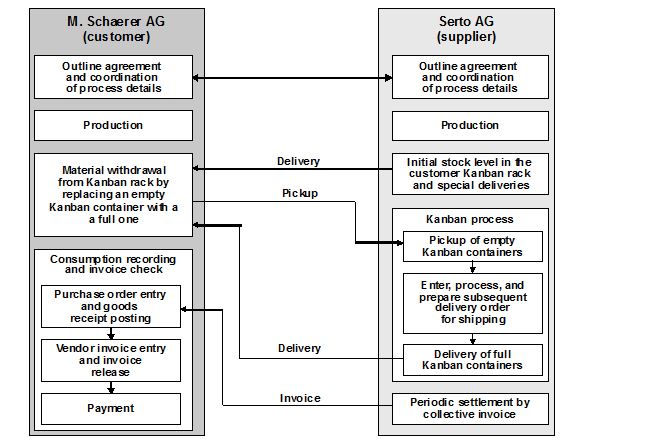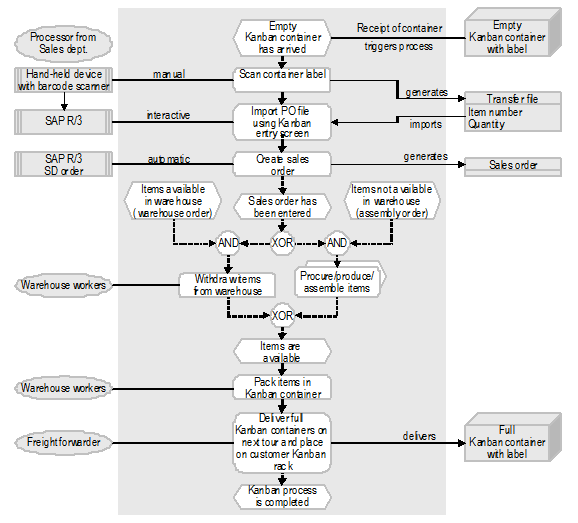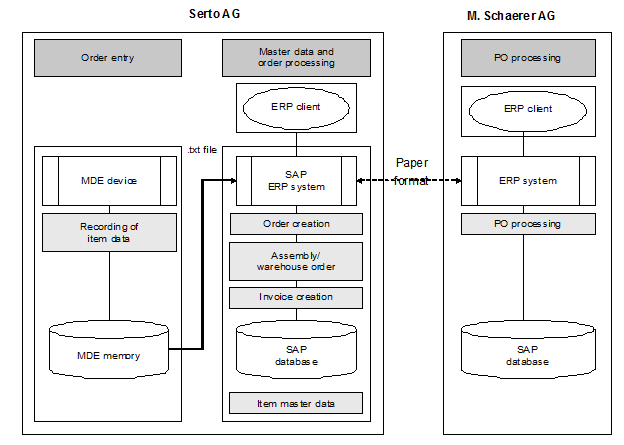Serto AG; Tube Technology: Kanban Solution for a Competitive Edge
It is perfectly possible to map a complex business process that extends beyond a company's borders in a simple way. This can be done using the reduce to the max implementation strategy. This case study presents just such a process, which was implemented using simple tools and results in considerable savings for both the company and its customers. It is a traditional Kanban process that was optimized for the local environment using a few technical tools and several organizational measures. Thanks to the simplicity of the process and a deliberate limitation to the existing standards in the ERP system, it was possible to significantly increase the efficiency of the existing order process very quickly and economically.
1. The Company
Background
Serto AG, which was spun off from its parent company Gressel AG on January 1, 2002, offers unique tube unions that can be mounted and dismounted radially. Over the years, this key product has been continuously developed and supplemented by additional products.
The Serto Group has its headquarters in Aadorf, where it employs around 70 people. It also has independent subsidiaries in Germany, France, Great Britain, and Italy. Serto AG is represented throughout Europe by over 30 general agencies.
Industry, Product, and Target Group
The history of Serto AG began in 1952 with the invention of a clamp ring union. This made it possible to mount and dismount tube unions radially, which enables a highly compact construction method that is particularly suitable for devices in which space is at a premium, such as coffee machines. Over time, a comprehensive system of tube union elements, valves, tubes, and mounting accessories has been developed around this invention. Besides its standard products, Serto also offers custom-made solutions in large and small-batch production. Its systematic customer focus has also lead to the development of supplementary services. One of these is order and logistical control for coffee machine manufacturers according to the Kanban principle.
Corporate Vision
As an independent company, Serto is able to implement a sustainable strategy to ensure its long-term survival. Serto implements this strategy through constant innovation in products and services and by focusing strongly on customers and markets.
2. What Triggered the Project
Initial Situation and Trigger for the Project
The motivation to optimize the traditional purchase order process originated from M. Schaerer AG in Moosseedorf. This customer was in the following situation: it ordered 190 different items a year from Serto in Aadorf to a value of CHF 800,000. The purchase order volume was triggered by means of 743 purchase orders (POs), each of which incurred an average outlay of CHF 100. This was associated with a relatively high capital lockup due to the customer warehouse stock. The customer was very dissatisfied with this situation and wanted to reduce future purchase order costs and the average warehouse stock as well as automatically trigger a smaller number of purchase orders with a larger purchase order volume.
By this point, Serto AG already had limited experience of connecting customers by means of Kanban. This process was designed for far smaller purchase order volumes, however, and did not require technical interfaces.
SAP Schweiz AG (Provider of ERP System)
SAP Schweiz AG is an international subsidiary of SAP AG in Walldorf (Germany), which was founded in 1972, employs more than 36,000 staff worldwide, and caters to over 33,000 customers. Its corporate goal is to provide end-to-end solutions for business processes. These software solutions are designed to help reduce costs, improve corporate performance, and enable companies to respond flexibly to business requirements. In this case study, both the customer and supplier use an SAP R/3 system. The SAP system was implemented at Serto by Swiss company TDS Multivision AG.
M. Schaerer AG (Customer)
M. Schaerer AG was founded in 1982 in Bern, and originally produced items for doctors' surgeries and hospitals. It produced its first coffee machine in 1957 and this now forms its core business. In 2006, the company was taken over by WMF AG in Geislingen (Germany). The takeover arose from an initial collaboration project in 2003. M. Schaerer AG remains an independent company and currently employees 220 staff at its headquarters in Moosseedorf.
3. Connecting Customers with Kanban
To enable Schaerer to efficiently plan the items it procures from Serto, the two companies rolled out a Kanban solution. Kanban means sign or card and denotes a replenishment method for production developed in the 1970s in accordance with the pull-principle [Ohno 1988]. The quantity to be delivered is based solely on consumption in production. The aim is to reduce warehouse stocks at both end product and supplier part level. Reducing warehouse stocks decreases capital lockup, lead times, and lot sizes. Kanban production is suitable for products with a high value (A or B parts), minimal fluctuations in demand, and few special requirements.
The Kanban solution implemented at Schaerer and Serto works as follows: The process is used to deliver parts classed as C parts. It brought about a significant reduction in the number of lots and warehouse stocks at the customer. The Kanban solution of the 1970s is primarily designed to optimize processes within a single company. Here, it is implemented at two independent companies, which requires a strong relationship of trust between customers and suppliers.
The solution is described in the following sections from a business, process, and application perspective.
Business Perspective and Goals
Customer connections always have two sides, one at the customer and one at the supplier, each with different strategic and operative goals. While the customer strives to ensure its supply at the lowest possible cost, the main priority of the supplier is to ensure customer retention. Both companies had already implemented Kanban solutions with other partners and were aware of the strategic advantages of this approach. For Serto, Kanban brought additional operative benefits in the form of regular deliveries, easier administration, simple, standardized business processes, and greater ease of planning. Warehouse stock at the customer is reduced, which means that less capital is required and placing purchase orders involves less administrative effort. Goods receipt and quality controls are unnecessary.
The Kanban process requires Serto to provide additional services. These include the weekly journey to the customer with its own truck and exchanging the empty Kanban containers for full ones at the customer plant. The customer is invoiced separately for these logistics costs.
If out-of-stock (OOS) situations arise at Schaerer due to fluctuations in demand, the required items can be ordered from Serto by telephone at short notice in a special purchase order. Serto retains a buffer stock of supplier parts for this eventuality.

Fig. 1: The Kanban Process as a Service of Serto AG
Process Perspective
A distinction is made at Serto between an internal and external Kanban process. The internal Kanban process is used to supply the individual internal warehouses (production warehouses) with single parts from the high rack warehouses (central warehouses). The external Kanban process is used for deliveries to customers. This case study describes the external Kanban process only.
Two containers are designated to each item that is managed in the Kanban system. These containers are stored one behind the other on a rack at the customer.

Fig. 2: The Kanban Process at Serto
The Kanban containers at Schaerer are exchanged every Thursday [Empties]: an empty container is removed and a full container delivered. When the empty, labeled containers return to Serto, the barcodes on the labels are read using a mobile data entry (MDE) device. This label contains information about the material and quantity to be stored in the respective container. A transfer file is generated and then entered manually in the SAP R/3 system by means of a Kanban entry screen, and an SD sales order is then generated. Next, an assembly order for standard parts or a warehouse order for special parts is created for Production or the warehouse. The single parts are packed, staged, and loaded into the containers. The parts are then delivered on Thursdays and the full boxes placed on the Kanban rack at the customer. Goods receipt and quality controls are unnecessary. Fig. 2 illustrates this process.
The quantity in each container must be defined such that it is not used while the other, empty container is in circulation. Serto creates a monthly collective invoice for the goods that have been delivered, whereby one order and invoice item is generated for each Kanban container. Based on this collective invoice, a purchase order for internal consumption is created manually in Schaerer's SAP R/3 system. The goods receipt is posted automatically and the vendor invoice entered. A payment to Serto is triggered when the vendor invoice is released.
Application Perspective

Fig. 3: Application Perspective and Integration Scheme
The two companies exchange information in one direction by means of the Kanban labels, and in the other direction by means of the collective invoice. Serto has implemented a semi-automated solution for entering orders. The item data is transferred from the MDE device to the SAP R/3 system by means of a structured text file that contains the SAP item number and the quantity only.
The main advantage of the Kanban solution at Serto AG it its striking technical simplicity. After initial efforts to enhance the ERP solution, Serto AG returned time and again to the standard solution. The solution described here uses the existing, traditional SAP system, therefore, which has been enhanced only to the extent that the import routines for the MDE data have been added.
4. Project Processing and Operations
Project and Change Management
An initial process analysis was carried out so that a tailor-made Kanban solution could be offered to the customer. The process was divided into four steps: determination of demand, purchase order process, production and packaging, and delivery. The following options were available for determining demand: an automatic order proposal in the ERP system, visual monitoring, and a Kanban card. Various options also existed for the purchase order processes, which mainly differed in their degree of automation. During the negotiations, a decision was made to adopt the solution currently implemented.
Schaerer chose a Kanban solution that comprises the following process steps: Demand is determined using a two-container system. A purchase order is triggered by an empty Kanban container. A backup supply purely for special parts is maintained in Production. The customer container is used as packaging and Serto delivers the goods in its own vehicle.
The project was implemented within three months and involved three Serto AG employees. The only limitation (which also applied during the SAP rollout) was that standard SAP functions were to be retained and development of customer enhancements avoided. The highly pragmatic solution replaced manual entry of purchase orders in the SAP system with an automatic purchase order creation function. This required one-off effort for programming and testing the interface to the MDE device. In addition to this, a weekly logistics effort is required for delivering and exchanging the Kanban containers and triggering the purchase order using an MDE device.
Development and Rollout of the Software Solution
The IT partner TDS Multivision required half a person day to implement the interface (for uploading the transfer file from the MDE device to the SAP R/3 system). Customer-specific adjustments were not made and the standard SAP system was used instead as strategically defined.
Continuous Maintenance
The solution that has been implemented does not require any specific availability aspects to be taken into account. The goods can also be delivered independently of the SAP R/3 system for a limited period of time.
5. Experiences
User Acceptance
User acceptance is very high at both the customer and supplier.
To the great relief of the sales employees at Serto, the rollout of the Kanban solution has rendered obsolete the time-intensive purchase order process (manual entry of purchase orders).
Thanks to years of effective collaboration and the fact that Serto processes orders in a very conscientious manner, Schaerer decided to carry out goods receipt and quality checks on a random sampling basis only. The Controlling employees, who initially had reservations about this, were won over by the smoothness of the workflow. As a result, invoices are always checked against the delivery notes, whereas goods receipts checks are carried out on a random basis only. The assembly employees needed time to get used to the two-container principle. It was necessary to enforce the rule that goods could only be taken from the front container. This became routine after an adjustment phase, however.
Achievement of Goals and Changes Brought About
Both the customer and supplier objectives defined have been met and the processes accepted. The volume of purchase orders that result from the Kanban solution with Schaerer comprises approximately eight per cent of the total purchase order volume. Since the process was implemented in the standard SAP system, no process-specific costs were incurred. The only additional costs are those for transport, for which the customer is invoiced separately.
From Serto's perspective, its customer relationship with Schaerer has been intensified by the close cooperation required by the process, meaning that one of its main objectives has been met. The greater insight into the customer processes that Serto has gained and the weekly insight into its production processes within the scope of the delivery of the Kanban containers has allowed it to extend the system to other products, sometimes at the expense of other manufacturers.
Investments, Profitability, and Key Figures
To determine whether the conversion to Kanban has been worthwhile, the costs were compared with the additional revenue generated. The following costs were incurred: vehicle and labor costs for picking up/delivering the Kanban containers, several transport mesh trolleys, a larger warehouse stock (backup stock), and programming of the interface. The MDE device did not need to be procured since it was already used in the inventory process. In contrast, the sales volume has nearly doubled and ordering costs have decreased.
6. Success Factors
What is interesting about this case study is the pragmatic approach to implementation and the potential to extend the process to other regions. It is also impressive that so little time was needed to examine and implement a customer idea.
The key success factors of a solution like this include the close collaboration and high level of trust between the customer and supplier. If this prerequisite is ensured, the administrative effort on both sides can be dramatically reduced, resulting in a win-win situation.
Reflection of "Process Excellence"
The pragmatic approach to implementation has given rise to a solution that is effective, simple, and at the same time manageable and user friendly. Its introduction required only a minimal infrastructure investment and affords Serto the flexibility to continue to adapt itself to changing situations. The solution can be extended, both to other customers and to applications in other international subsidiaries.
A niche vendor from the high-salary country of Switzerland can intensify and cement its customer relationships by offering not only an outstanding product, but also a high level of integration with the logistics processes of its customers. A focus on service and a willingness to adapt are rewarded by stable customer relationships and a predictable order volume.
The way in which the ERP systems are used is also interesting. Both companies use an SAP R/3 system to record material and value flows seamlessly and accurately. Manual transactions are included both prior to and between defined process states if the cost-benefit-flexibility ratio shows that this is the best solution.
The external Kanban process described here can be developed and enhanced further. With a greater degree of automation, for example, Serto could transfer its outgoing invoices to Schaerer, which could post them using a program. This would remove the need to enter the individual invoice items as purchase orders. At the same time, the process could also be extended on the supplier side at Serto AG. This would be the next step in process integration.
Lessons Learned
Serto AG wants to continue to receive and examine ideas from customers and retain its pragmatic approach to implementation. It applies its motto of reduce to the max to the optimization and adjustment of business processes.




